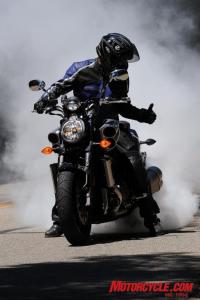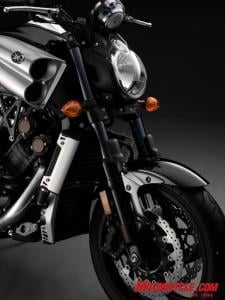Royal Distributing will bring in members of its KTM dirt bike and ATV race teams, including Canadian Motorsports Racing Club Women’s Division champion Jacqueline Ross. The CMRC will also be at the Supershow to promote its national Motorcross and ATV Racing series, and to host the Ontario Championship banquet. Dirt track racing announcer Frank Wood will be interviewing racers throughout the weekend on the Racing and Performance stage in Hall 4. Race fans can also meet some future champions as the MX Stars of Tomorrow will make an appearance. Other special guests scheduled for attendance include author and adventure rider Jeremy Kroeker and Dakar racer Lawrence Hacking. Canadian motorcycle enthusiasts can start the new year with the North American International Motorcycle Supershow. Local off-road riding associations will be represented at the Supershow. The Ontario Federation of Trail Riders, Ontario Dual Sport Club and Ontario Adventure Riders are some of the organizations who will be available to answer questions. The North American International Motorcycle Supershow takes place at the International Centre in Toronto. For more information about Supershow, visit http://www.supershowevents.com/.Racers, motorcycles and clubs featured at 2009 show
Canadian Motorcross fans can meet some of their favorite racers at the North American International Motorcycle Supershow, Jan. 2-4 in Toronto, Ontario. Show organizers have expanded the off-road segment for the 2009 event to include a large number of racers, motorcycles and clubs. 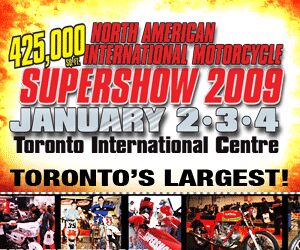
Motorcycle.Com Tips and Tricks How-To Feed
Wednesday, December 31, 2008
Supershow expands off-road segment
Diposkan oleh edie di 11:15 AM 0 komentar
Label: off-road segment, Supershow expands
December 2008 recall notices
Ducati, Harley-Davidson, Kawasaki, and Triumph issued recall notices through the National Highway Traffic Safety Administration in December 2008. Ducati is recalling 2007-2008 models of the 1098, and the 2008-2009 versions of the 848 sportbikes due to a problem with the charging system. Engine heat may cause damage to the voltage regulator of the affected bikes, leading to battery discharge. The recall affects 7,130 bikes including the 1098S, 1098R and 1098 Tricolore. Dealers will replace the voltage regulator and install a heat guard between it and the engine exhaust system. Dealers will also install a modified battery support. Motorcycles produced after May 2008 already feature these revisions. Harley-Davidson is recalling 2009 Dyna motorcycles, including the Super Glide, Super Glide Custom, Street Bob, Fat Bob and Low Rider. The affected motorcycles, produced July 24 through August 28, may have faulty welds on the jiffy stand’s spring anchor. The defect may prevent the stands from properly retracting. Harley-Davidson says 3,285 motorcycles may be affected by this problem. Harley-Davidson also issued a second recall notice for 2009 Super Glide Custom, Street Bob, Fat Bob and Low Rider motorcycles because of a fault with the fuel tank vent tube assembly. An ultrasonic weld on the anti-slosh valve of the assembly may be defective. A fuel leak may occur if the valve separates and the affected motorcycle is tipped over. Harley-Davidson says 349 motorcycles, built July 22-25, are included in the recall notice. Dealers will replace the jiffy stand spring anchors on the 3,285 motorcycles affected by the jiffy stand defect. Dealers will also inspect the fuel vent tube assembly on bikes included in the second recall notice. Kawasaki is recalling 2008 Concours 14 motorcycles due to a problem with the rear brakes. Road debris may get trapped between the rear brake pedal and the rear master cylinder actuating arm, preventing the pedal from fully releasing. This could cause the rear brake to overheat and may leading to rear brake lock-up or failure. Kawasaki has yet to provide a remedy for this problem, but will reimburse customers who experience this problem if the failure was not already covered by warranty. Kawasaki says 4,628 motorcycles are affected by this problem. Triumph is recalling 2008-2009 Thruxton motorcycles due to a problem with the front brake. Bolts installed on the front brake caliper bracket may be too short. When undoing the bolts for service, the mating threads on the caliper mounting may become damaged, potentially causing the brake caliper to come loose. Riders may notice a “clunk” noise when applying the front brake if they have this problem. Triumph will replace the bolts on the 87 Thruxtons covered by the recall notice. Triumph also issued a recall notice on 2008 Rocket III Touring motorcycles due to a problem with the saddlebag assembly. The affected bikes may be missing a weld on the back of the pannier rail supporting the bags. After time, the pannier rail may weaken and fracture, causing the saddlebags to fall off. The recall notice affects eight motorcycles, Dealers will replace the pannier rail on the affected motorcycles.
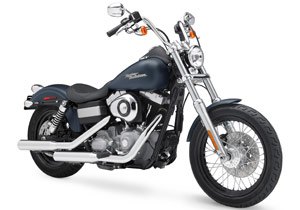
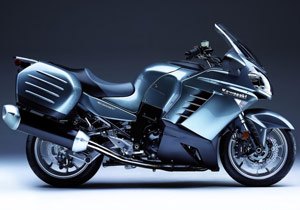
Diposkan oleh edie di 11:08 AM 0 komentar
SPEED to air AMA SX through 2013
SPEED will air events from AMA Supercross, an FIM World Championship, through at least 2013. The arrangement also gives SPEED the right to broadcast events from other Feld Motor Sports properties, AMA Arenacross, United States Hot Rod Association Monster Jam and International Hot Rod Association Nitro Jam. Contracts for the AMA Arenacross series and USHRA Monster Jam run through to 2012 while the IRA contract is a one-year deal for 2009. “This new deal with Feld Motor Sports delivers a diverse collection of racing properties for our viewers,” says Hunter Nickell, president of SPEED. “It is a great blend of competition and entertainment ... a mix that already has proven to resonate with a large number of race fans.” Chad Reed will begin his SX title defence Jan. 3 in Anaheim. Exclusive content from the AMA Supercross and AMA Arenacross series will be available during the season through SPEEDtv.com, VOD cable, iTunes video podcasts and mobile phones. Full races will be available on VOD cable and through select mobile carriers. SPEED will also offer “best of” clips of USHRA Monster Jam action through its online and wireless outlets with 2009 Freestyle events available on iTunes and Amazon for $1.99.Coverage begins with Jan. 3 season opener
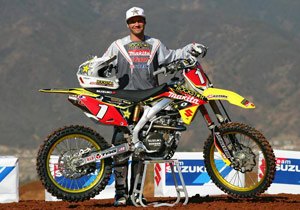
Diposkan oleh edie di 11:06 AM 0 komentar
Label: SPEED to air, SPEED to air AMA SX
2009 Star V-Max Review/Test
This is a follow-up to our quickie ride story posted just one day after sampling the bike at its world press introduction in San Diego County. Here we delve deeper into the details of the exhilarating new VMax. The word icon is described as an important and enduring symbol. For Yamaha and Star Motorcycles, the VMax stands near the top of its bikes eligible for icon status. First seen in 1985 and barely revised since, this all-new VMax has gone through a decade-long gestation, with development work going back to 1997. The first running prototype was judged to be too big and the power too linear. The 2009 Star Motorcycles VMax - an icon reinvented. Now sold under Yamaha's Star Motorcycles banner, engineers grappled with the concept of a rebirth of a legend. Star is positioning the new VMax at the edge of the expressive/aggressive personality of the modern cruiser category. As such, they use terms like hot rod, muscle, power and respect to describe what the VMax represents. To make sure Star was hitting its target audience, they conducted extensive market research with focus groups. Owners of the previous generation (which have an average age of 45-plus years) insisted a new version should have improved handling, increased power, a better riding position and continued use of shaft drive. And they were adamant for Star to use a V-Four engine and "keep the V Boost!" Key to the new VMax's success is a cast-aluminum frame that uses the giant engine as a stressed member. Bringing the VMax into the 21st century required enormous improvements to the flexi-flyer steel chassis of the old bike, so they threw it out and created an aluminum frame that uses the imposing engine as a stressed member for added rigidity. But getting a long, shaft-driven chassis to handle up to Yamaha's standards proved to be the most challenging aspect of the new bike, causing a delay to the bike's introduction until they got it right. The production version of the chassis consists of a cast-aluminum perimeter-style frame and new alloy swingarm. The subframe is made from Controlled-Fill cast-aluminum sections and extruded-aluminum. The chassis' geometry is closer to cruiser specs than sportbike numbers, with a 31.0-degree rake, 148mm of trail, and a 66.9-inch wheelbase. The previous model had sportier geometry: 29.0 degrees, 119mm, and 62.6 inches, respectively. This latest Max is about an inch wider and 3.7 inches longer overall. It all adds up to a machine with immense visual punch. The VMax's crowning accents are the aluminum air intake scoops that are now functional. The scoops are hand-polished to a fine luster (taking 40 minutes each!) then are clear-coated for an enduring shine. A large tachometer figures front and center with an inset digital speedometer. Tank-top info screen is small and hard to see while riding. Upon firing, the VMax settles into a steady but menacing rumble. The V-Four, with its contra-rotating balance shaft, is quite smooth, but a rider never forgets there is something substantial reciprocating between the knees. A blip of the throttle reveals a fairly heavy flywheel effect, as revs don't soar as quickly as smaller, sport-oriented engines. Though built as compact as possible, the 1679cc V-Four VMax motor is a substantial lump. Exhaust cams are gear-driven by the chain-driven intake cams. Forged-aluminum pistons sit atop fracture-split connecting rods, just like the latest sportbike motors. A convoluted exhaust system spits spent gasses out of titanium-skinned quad-exit mufflers. When building a replacement motor for an icon like the VMax, Yamaha/Star engineers knew they had to recreate a legend. While the old 1198cc V-Four was the bees' knees in 1985, it would take a large injection of power to be king of the hill in 2009. The mantra of the muscle-car era was "there's no replacement for displacement," and the new VMax hums the same tune. While its 66mm stroke was retained, the '09 Max gets a big-bore treatment by enlarging its cylinders from 76mm to 90mm. This yields an engine with 481cc extra, a 40.2% bump to 1679cc. Like the upcoming Aprilia V-Four Superbike engine, the VMax uses a chain to drive the intake cams, and from there a gear-set turns the exhaust cams, keeping the engine as short as possible. Valve-adjustment intervals are only every 26K miles. Star also tightened up the 70-degree vee cylinder angle to 65 degrees, also the same as the Aprilia mill. Combined, this tightened up the distance between the cylinder heads by a little more than 1 inch, and the monster motor is 7mm shorter overall. Much of this new engine uses technology seen on Yamaha's top-line sportbikes. A Mikuni fuel-injection system uses a quartet of 48mm throttle bodies with 12-hole injectors, and it's operated by Yamaha's ride-by-wire Chip-Controlled Throttle (YCC-T). The three-processor ECU measures parameters (wheel speed, crank position, temperature, etc) every 1/1000th of a second. Interestingly, a Star-supplied chart says YCC-T also takes into account a lean-angle sensor, which, along with the standard ABS's wheel-speed sensors, could be deployed as a traction-control system. A look at our tire-melting video shows this not to be the case. Also borrowed from Team Blue's R-series sportbikes are variable-length intake stacks (YCC-I) that use 150mm snorkels for strong torque at low revs. At 6650 rpm, the trumpets raise up to reveal shortie 54mm intakes for a V-Boost-like top-end hit that voraciously rockets the bike quickly through the gears. Inside the motor are more sportbike-derivative pieces. Pistons are made from lightweight forged aluminum, and they rise and fall on the 180-degree crank inside ceramic-composite cylinder linings. The connecting rods are fracture-split and carburized for strength. The new combustion chamber is much flatter (a 29-degree included valve angle) and nets an 11.3:1 compression ratio which requires premium fuel. Magnesium engine covers try to keep weight down as much as possible. Spent fuel exits into four header pipes that join in a large under-swingarm collector before flowing into a pair of four-exit mufflers with titanium skins. Inside are an oxygen sensor, two catalyzers, and an EXUP power valve. What it all adds up to is a colossal 197 crankshaft horsepower at 9000 rpm. The final version of the previous VMax (last sold in '07) was rated at a paltry 133 hp at 8000 rpm, a whopping 48.0% less. Prodigious, too, is the new Max's torque production. Its 122 ft-lbs at 6500 revs dwarfs the 86.8 ft-lbs at 6000 rpm of the old bike to the tune of 40.6%. There is so much power on tap that a Star rep related a story of how its rear tire was slipping on a rear-wheel dyno drum when testing its max power. Even adding a passenger didn't completely stop the slipping! I didn't manage to get him to reveal what numbers came up on Yamaha's Dynojet, but reading between the lines, we expect rear-wheel dyno figures approaching 180 hp. Note that Suzuki's B-King pumps out about 160 horses at the back wheel. With nearly 180 rear-wheel horsepower on tap, the VMax gets down the road like nothing else on it. The VMax is fitted with a drive system that helps and hurts. Hydraulic clutch actuation eases lever effort, and gearbox throws in the 5-speed tranny are short and precise. A race-style slipper clutch works okay, but it seems a bit incongruous to be doing high-rpm downshifts on a so-called cruiser. However, this is no ordinary cruiser and, in fact, might better be labeled something like a muscle naked. Star's Warrior is correctly termed a power cruiser, and the VMax is certainly something quite different. The VMax's rear wheel is driven by a shaft, creating some suspension issues but enhancing its tire-smoking corner-exit abilities. While the gearbox is first-rate, the shaft-drive system partially falls on the negative side of the ledger. Focus groups may have insisted on a shaftie, but this arrangement has its dynamic compromises, no matter how well it's designed. It's heavier, so a rear suspension can't react as quick, and it also makes the bike suffer a jacking effect that results in a stiffer and higher rear end when under power. However, this shaft-drive byproduct has hooligan benefits of its own. Without much rearward weight transfer, the reasonably sticky 200mm Bridgestone BT028 has a snowball's chance in hell of not melting when the V-Four is given its head. If you've even been foolish enough to want to mimic the rear-wheel-sliding corner exits of pre-traction-control GP riders, the VMax stands head and shoulders above anything else on two wheels. Tire-spinning corners exits have been part of my fantasy world that rarely transfer into actuality, but Mr. Max makes them ear-to-ear-grinningly real. In regard to the bike's ultimate acceleration, the VMax is absent a probable electronic trick and equipped with an unexpected one. First, we're thrilled to report the ECU doesn't limit power in the lower gears like on many other modern hyperbikes. Electronic intervention comes into play once 220 kph (136.7 mph) is reached, as this is the Max's top-speed limiter. However, to not handcuff dragstrip performance, the limiter is lifted to a 230-kph (142.9 mph) threshold when a quarter-mile acceleration run is sensed! For what it's worth, I saw 145 mph on the speedo before I ran out of open road. When it comes time to shed speed, the new VMax is worlds apart from the wimpy brakes of its forbear. Up front, a four-position lever actuates a Brembo radial-pump master cylinder that feeds a pair of 6-piston radial calipers biting on 320mm wave-type discs. They proved to be very powerful but not overly sharp. A Brembo rear master cylinder powerfully fires a single-pot caliper and 298mm wave rotor, and it was when using the rear brake that I was grateful for the bike's standard ABS which isn't intrusive. In terms of real-world usability, the VMax performs better than expected, although it's a bit clumsy at lower speeds. The narrow handlebar and cramped riding position of the old bike has been opened up by moving the grip position an inch further forward and about a half-inch taller. The seat height is listed at a modest 30.5 inches, but its broad seating area gives narrow-hipped people like me a bit of struggle to reach the ground firmly with both feet. A stepped seat-back isn't just for comfort; it's also to keep you aboard the bike during 1G acceleration. Extra menace can be found in the carbon-fiber section of the Star accessory catalog, accented by billet-aluminum bling. Few materials are as emblematic of contemporary speed and racing as is lightweight carbon fiber, and Star delivers with an assortment of lovely composite pieces manufactured in-house. Tasty carbon bits include fenders, tank covers, seat cowls and side covers, but the beautifully made stuff isn't cheap. A set of the C-F air intake scoops costs a whopping $999.95. Functional components include a flyscreen, touring windshield, hard saddlebags and a passenger backrest. An optional tail pack can attach to the passenger seat or an accessory aluminum luggage rack. Upping the bling factor is as easy as bolting on some billet aluminum covers for the cams, master cylinders and swingarm pivot. The VMax's riding position is open and comfortable for rides longer than a quarter-mile. Underneath the seat is 3.96-gallon fuel tank, same as the old bike, which helps lower the bike's CG. The VMax manages decent heat control through its dual radiators that keep its frontal area as slim as possible. Out of Ramona, stuck in traffic, I could feel a little heat on my ankles and shins, but not bad considering the engine's enormous output. There are decent views out of the bar-mount mirrors for keeping an eye on your tail during your inevitable extra-legal antics. Freeway cruising is very comfortable for a naked, as a rider is sitting down in the bike, making even a 90-mph lope (with its overdriven fifth gear) quite bearable. A 2-year warranty adds peace of mind. Star should be commended for the suspension it fitted to the Max. Both ends are produced by Soqi, a Yamaha subsidiary, and both the 52mm fork and single shock are adjustable for spring preload and both compression and rebound damping. But their best feature is tools-free knurled knobs to easily dial in optimum rebound damping at both ends, plus rear compression damping; a screwdriver needs to be unsheathed only for front compression. The rear end also has a handy hydraulic preload adjuster on the bike's left side that can be altered on the fly if you're flexible - otherwise, do it easily at a stop. Although there are better bikes for cutting up the twisties, the VMax acquits itself well for a machine of its size. Who wants to rumble? More successful is the new VMax's handling qualities, one of the old bike's weakest aspects. Now with the new aluminum chassis, a beefy fork and a forged-aluminum lower triple clamp and a cast-aluminum upper, the big Star is ready to intimidate lesser riders on pure sportbikes down a canyon road. Although it makes a Suzuki SV650 feel like a mountain bike in comparison, its handling is better than expected, with a chassis that feels stiff and responsive in steering transitions and a fork that offers decent front-end feel. You don't have to be a racetrack refugee to drag pegs on the VMax, but available lean angle is actually very respectable for a beast like this. Any handling deficiencies it has are related to throttle response and the shaft drive. The YCC-T is endowed with a program to reduce engine braking feel by letting a bit of fuel seep through on trailing throttle, and this works seamlessly most of the time. But in some instances, the compression-braking effect is quite pronounced and, worse, unpredictable when it happens. Chopping the throttle mid-corner can unsettle the chassis, and a rider can feel some drivetrain lash with an uncertain throttle hand in corners. The 2009 VMax - like nothing else. Recreating an icon is never easy, but that's exactly what Star and Yamaha have done with the 2009 VMax. It has a few flaws and limitations, but its overall persona extends the Max's icon status. It's as distinctive as bikes come, it has terrific attention to detail, and it offers a thrill ride that can't be equaled by anything else on two wheels. Just 2500 units (with commemorative badges) will be available for the 2009 model year, and more than half are already sold. You only have until October 31 to get your order in on the '09 VMax. Those who ordered early should see their bikes by the first part of November.
______________________________
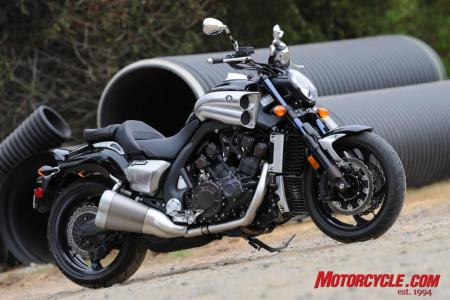


The Heart of the Beast
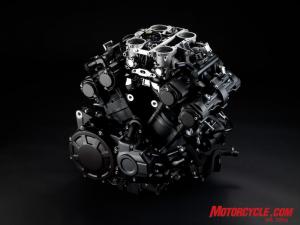
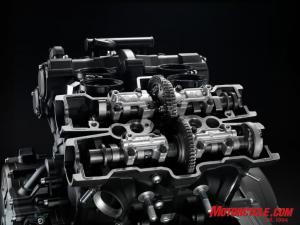
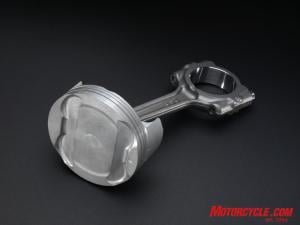
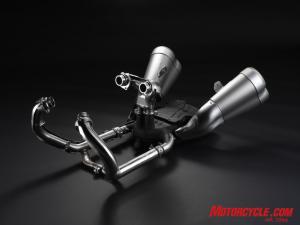
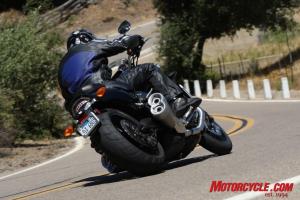
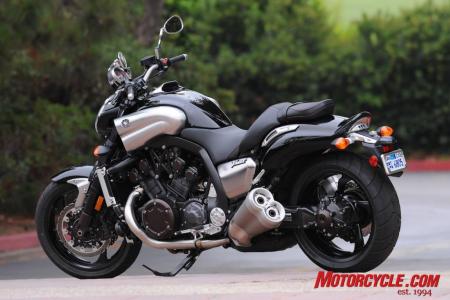
Dressed to the Nines 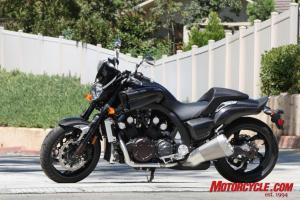
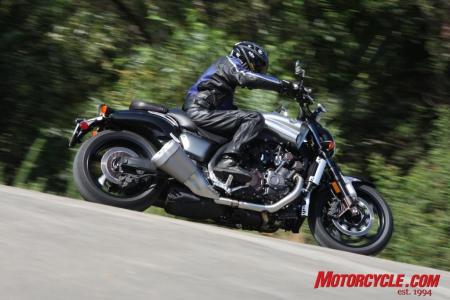
The suspension is good stuff, but it is faced with the formidable task of controlling a hefty machine and its shaft-drive dynamics. Action from the titanium-oxide-coated fork legs is quite good, even with substantially increased spring rates. But the rear end often struggles with isolating bumps, faced as it is with the shaft-drive compromises. Backing off rear preload and compression damping soothed things somewhat, but it never responded like an optimized chain- or belt-driven bike. 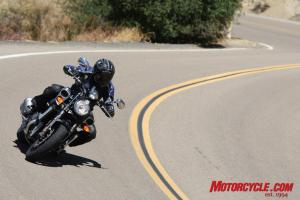
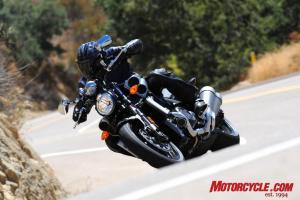

When I first heard about the new VMax, I had two thoughts: First, it was about damn time! Second, hanging a $17,990 price tag on a Japanese bike can be akin to wearing cement shoes. But while I still wonder how well second- and third-year models will sell, I do see a lot of value in this scintillating machine.
Highs: Sighs:
Diposkan oleh edie di 11:03 AM 0 komentar
Label: 2009 Star, V-Max Review
Supershow 2009
Now in its 33rd year, the show has not only grown in size, but has diversified to include trailers, ATVs and scooters. The show will also feature custom choppers, vintage bikes, vendors and clubs to check out. Plenty of interesting folks will be at the Supershow to meet and greet show attendees such as Lawrence Hacking with his Dakar bike, custom builder Steve Broyles, who will be bringing his latest and greatest creations, and Bar Hodgson with his 2008 land speed record attempting Team Arrow Bonneville Streamliner. Whether you are looking for bike gear, bike books, bike accessories or even a new bike, you are likely to find the goods you desire at the North American International Motorcycle Supershow. The North American International Motorcycle Supershow runs from Friday Jan. 2 (10a.m-10p.m.) Saturday, Jan. 3 (10a.m-10p.m.); Sunday, Jan. 4 (10a.m.-6p.m.) at the International Centre – 6900 Airport Rd. Mississauga Visit http://www.supershowevents.com/ for more info.Show spans 425,000 square feet
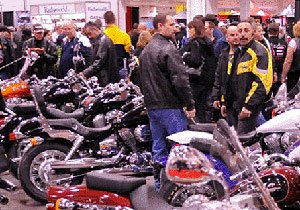 British bike expert Mike Partridge will be running a seminar on Saturday evening and will be on hand to answer questions all weekend. A couple of wordsmiths will also be in attendance to talk shop and sign books. Motorcycle Therapy author Jeremy Kroeker and Mark Richardson, who recently wrapped up his publicity tour for Zen and Now: On the Trail of Robert Pirsig and the Art of Motorcycle Maintenance will both be on hand.
British bike expert Mike Partridge will be running a seminar on Saturday evening and will be on hand to answer questions all weekend. A couple of wordsmiths will also be in attendance to talk shop and sign books. Motorcycle Therapy author Jeremy Kroeker and Mark Richardson, who recently wrapped up his publicity tour for Zen and Now: On the Trail of Robert Pirsig and the Art of Motorcycle Maintenance will both be on hand.
Diposkan oleh edie di 10:52 AM 0 komentar
Label: Supershow, Supershow 2009
Kawasaki to quit MotoGP
British motorsports site Autosport.com reports the Japanese manufacturer will announce its withdrawal from MotoGP racing on Jan. 5, 2009. A Kawasaki withdrawal would leave riders John Hopkins and Marco Melandri without a ride and reduce the MotoGP grid to 17 entrants and four manufacturers. If Kawasaki does withdraw from MotoGP, it would follow other Japanese manufacturers who John Hopkins had a disappointing 2008 season with his performance hampered by an injured ankle. Marco Melandri also had a poor 2008 season and was looking to turn things around with Kawasaki. Recent performance may also be a factor for Kawasaki to pull out of MotoGP. Ramona, Calif. native Hopkins and Australian Anthony West had difficult seasons in 2008, finishing 16th and 18th respectively in a field of 18 regular competitors. In August, Kawasaki signed Marco Melandri to replace West in 2009. Melandri finished the 2008 season sandwiched between Hopkins and West in 17th place. Hopkins, Melandri and test rider Olivier Jacques participated in the test session of the 2009 Kawasaki Ninja ZX-RR, Nov. 26-28 on Australia’s Phillip Island circuit. Related Reading Reports from Europe say Kawasaki is pulling the plug on its MotoGP race team
have recently pulled out of major motorsport competitions. Honda announced in early December its withdrawal from Formula One and AMA Road Racing while Suzuki and Subaru both opted to shut down their World Rally Championship programs. The current economic situation was cited as a main factor behind the announced withdrawals. 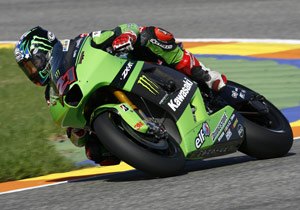
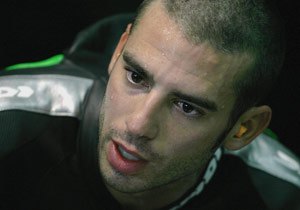
MotoGP: Kawasaki, Suzuki finish tests
Kawasaki Japan Tour
Diposkan oleh edie di 10:43 AM 0 komentar
Thursday, December 18, 2008
The Streets a Racetrack
Excess. For good or for bad, it’s something that has plagued me ever since I can remember. Whether it’s riding, partying, working-out, or [insert your activity here], you can count on me to totally overdo it. Thankfully, as I’ve grown, I’ve finally begun to recognize my peculiar trait and under normal circumstances I can cope pretty well. That is until I recently got the keys of one shiny new Ducati Desmo D16RR.
There’s just something about racing around on a loud, scratch that, ground trembling V-4 powered and street-legal 2006-spec MotoGP bike. The fact that you’re riding on a machine that costs more than most people’s car can put a pretty healthy grin on your face. Add in the 180-some horsepower at your right wrist’s disposal and a person like me is as giddy as a 16-year-old spun off a 4-pack of Red Bull.
And this in essence is the problem with Ducati’s D16RR. You see a person like me, just has to use all 180 of those horsepower pretty much everywhere he goes, all the time. The visceral thrill of the Ducati’s 990cc engine when it bursts alive at 10,000 rpm is pure addiction. The way the front wheel creeps toward the sky, while the engine screams as if it is only moments away from exploding is simply irresistible.
I absolutely love this motorcycle as it is embodies everything awesome about sportbikes, but, alas, Ducati will you please make us return it. My brain, and driver’s license for that matter, can only take so much abuse.
Diposkan oleh edie di 3:08 PM 0 komentar
Label: Racetrack, The Streets
Millen to Ring in 2009 with Truck Backflip

Rhys Millen seeks redemption for what was supposed to be a New Year’s celebration a year ago before a training accident derailed his plans.
Millen will attempt to become the first person to complete and land a backflip in an off-road truck. Set to take place at the Rio, Millen’s flip demands the truck to travel a distance of 80 feet at a height of 50 feet. During his final practice before the 2007 Red Bull New Year’s event, Millen overshot the landing, resulting in injury, damage to his vehicle and his withdrawal from the event. The 36-year-old New Zealand native is fully recovered and more determined than ever. Millen’s motorsports credibility is unrivaled. He was the 2005 Formula Drift champion and 2008 Red Bull Drifting World Championship winner and Pikes Peak International Hill Climb world record holder, and has been the lead stunt driver in several commercials and movies, such as Dukes of Hazzard and Fast and Furious: Tokyo Drift.

Robbie Maddison will follow up his history-making motorcycle distance jump with another world-first performance.
Shortly after Millen’s performance, Robbie Maddison, a 27-year-old Aussie, will jump his bike more than 120 feet high and land on the top of the 96-foot-high and 40-foot-deep replica Arc de Triomphe in front of Paris Las Vegas. Upon completing the jump, he will then drop off the Arc and freefall 50 feet to a massive landing ramp below. This follows his 322-foot-long jump last New Year’s Eve.
In addition to the ESPN telecast, the show will be simulcast live on www.ESPN360.com. A limited number of tickets will be available to witness Millen’s flip. Viewing of Maddison’s jump is free to the thousands of revelers on the world famous Las Vegas Strip.
For event information, as well as information on Maddison and Millen, visit www.redbullnewyearnolimits.com.
Diposkan oleh edie di 2:59 PM 0 komentar
Label: Millen to Ring, Truck Backflip
Suzuki Announces 09 GNCC & WORCS Lineup
Joshua Strang and Charlie Mullins will ride the race-proven Suzuki RM-Z450s in their pursuit of the 2009 GNCC championship. Coming off a stellar 2008 season in which Team FMF Suzuki captured 13 straight podium finishes, as well as five overall victories, the team’s goal for ‘09 is to capture the elusive GNCC number one plate. In addition, Strang will be looking to best his sophomore season which included a string of second place finishes and his first overall victory. While Mullins looks to improve upon his numerous podium finishes including one overall victory. Strang and Mullins kick off their quest at the GNCC season opener in River Ranch, Fla., Feb. 28 – March 3, 2009.
“We are really excited for the 2009 racing season to begin,” said Mike Webb, manager, Team FMF Suzuki Off Road. “Joshua had an incredible sophomore year last season. I know he has stepped up his pre-season training even more than last year and I can’t wait to see him take on Florida. In addition, we are working to get Charlie dialed in on the RM-Z450. Last year, Charlie had a slew of podium finishes as well as an overall victory. With his skills and his will to win, we are looking forward to great results racing GNCC.”
In the World Off Road Championship Series, Nathan Woods is healthy and ready to compete on his Suzuki RM-Z450. In 2009, Woods will pursue his third WORCS championship. While in the WORCS Pro2 class, Jonathan Davis will be out to capture the number one plate for the team. Woods and Davis kick off the first of 10 races in Phoenix, Ariz., Jan. 16 – 18, 2009.
“We look forward to going racing with the lineup that we have in 2009 for both GNCC and WORCS,” said Mike Webb, manager, Team FMF Suzuki Off Road. “With proven riders in Strang, Mullins, Woods and Davis, we are set in our quest for the number one plate in their respective series.”
For more information, visit www.teamsuzuki.com or www.suzukicycles.com.
Diposkan oleh edie di 2:55 PM 0 komentar
Label: Suzuki Announces, Suzuki Racing
